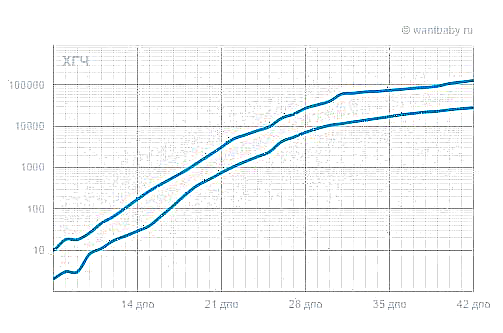
Modern women have learned about the existence of innovative electronic pregnancy tests relatively recently, but immediately these test systems won fame as more sensitive, informative and accurate. Whether they correspond to these characteristics and what are their features, this article will tell.

Description and principle of operation
The principle of operation of electronic tests is no different from the principle of operation of conventional strip strips, with which women have been familiar for a long time. The test contains a layer impregnated with a reagent that is especially sensitive to an increase in the level of a special hormone in the urine - chorionic gonadotropin. This substance in a woman's body begins to be produced in large quantities by the villi of the outer part of the ovum, with which the embryo is attached to the wall of the uterus.
After implantation, which usually occurs between 6 and 9 days after conception, there is an increase in hCG in a woman's blood about twice every two days.

HCG is very important for the development of pregnancy, because it maintains the corpus luteum formed on the ovary after ovulation from the remnants of the follicular membrane in an efficient state... It produces progesterone, a hormone without which it is impossible to maintain a pregnancy.
In the blood, the level of chorionic gonadotropin rises faster and is determined earlier than in the urine. But usually, by the first day of missed menstruation and in the urine, the level of the hormone is sufficient for sensitive tests to be able to determine them. Electronic tests have a high sensitivity threshold, and therefore they can detect traces of hCG in the urine even a couple of days before the start of the delay.
If such a hormone is found, the test shows a positive result. In digital tests, it may look somewhat strange and unusual: these are not stripes, to which everyone is accustomed, but "pros" and "cons". Some test systems can determine the approximate duration of pregnancy in weeks by the concentration of the hormone.
The digital test is reusable, which means that a woman can use it several times, simply by changing the disposable earbuds.

How to use?
While electronic test systems are considered the most accurate today, manufacturers and women's health professionals it is not advised to use them before delays - if ovulation occurred late or implantation was "delayed", the hCG level will be too low and the woman runs the risk of getting false negative.

Testing is considered optimal. from the first day of the delay.
It is best to do the test using morning urine. After a night's sleep, urine is denser and more concentrated, which will help the reagent more likely to catch traces of hCG if there is not much of it accumulated.

After a delay, a woman can do electronic test at any time of the day - the amount of chorionic gonadotropic hormone by this time is sufficient for recognition by the test system.
There is no need to collect urine for testing. The electronic test is a jet test, it is enough to bring it under the stream of urine during urination for 5-6 seconds.

It is very important to do this so that the liquid does not get on the working part of the case with the electronic "filling", otherwise the device can be damaged.
If you are afraid not to cope with this task, collect the urine in a clean and dry container and dip the test part of the device, but for a longer time - 20 seconds on average (more precisely, you can read the instructions for use).

After the test is wet, a timer is displayed on the electronic board, which means one thing - the process of analyzing the information received is in progress. It takes about 3 minutes, then the result is displayed on the scoreboard. It looks like "+" or "-", or a specific indication of the words "pregnant" or "not pregnant".
If the test is with the definition of a period with an indication in weeks, then he indicates it in accordance with the average norms of hCG. If the pregnancy is multiple, the test will show the period longer than it is, and when testing for a rather long period, it will indicate the maximum indicator for a particular test system.

In the timing, the electronic test can be wrong, it can deceive, the ultrasound method is more accurate in the early stages of pregnancy.
If the result is positive, two weeks after the start of the delay, you can visit the ultrasound diagnostics room and clarify the question of the term if it raises questions and doubts.

One insert cannot be used twice or three times. It must be disposed of after receiving the result. But this should not be embarrassing, because 20 cartridges are included with the device, which means that a woman will be able to test 20 times, but with each subsequent time, the accuracy and efficiency will not decrease.

You will learn more about the rules for using electronic pregnancy tests by watching the following video.
Pros and cons
Electronic tests (don't confuse them with electrical ones!) Are often praised, and therefore it is worth starting a review of the features with negative points. First, such tests are expensive. Their cost ranges from 300 to 500 rubles (the price depends on the region). Despite this, such tests are increasingly being asked in pharmacies.

The very fact that the test system is electronic, increases the likelihood of a software error or a factory defect. No one is immune from this, as with the purchase of any electronic device. You should not try to fix it yourself, even if you have an engineering degree. Disassembled test will not be exchanged. In other cases, like any electronic device, the digital test will be exchanged in the event of a malfunction.

More pluses... Firstly, this is a high level of sensitivity, which makes the test acceptable to be carried out before a delay of 2-3 days, and some systems can recognize traces of hCG even 4 days before the expected day of menstruation due to the special sensitivity threshold of the reagent on removable cartridges - from 10 units per milliliter. Secondly, it is quite convenient to use such a device, and a woman can conduct testing not only at home, but also where it is convenient for her. For the self-diagnosis procedure, neither a container nor a pipette is needed.


The third plus, in our opinion, is the most noteworthy - a digital device will never show a questionable result. No ghost stripes, no faint second stripes that cause confusion, excitement and a lot of questions in a woman. Only yes or no. No options.
The test saves the test results for a day, and therefore there is no need to fear that as it dries, the positive result will suddenly turn into negative, that the strip will change color, etc. During the day you can please your spouse and present indisputable proof of a quick replenishment - positive, beautiful aesthetically pleasing test.


Why can it be wrong?
As already mentioned, a digital test can still give an erroneous result. In what situations is it possible.
If testing is carried out much earlier than the term - after conception in a few days. Until implantation took place, the level of hCG in pregnant and non-pregnant women in the blood and urine is exactly the same, and the test will show a negative result.

- If a woman has taken drugs containing chorionic gonadotropin in the current cycle - HCG is administered once to ripen the eggs during IVF, also when stimulating ovulation with hormonal drugs. After that, the tests give positive results within 10-14 days, even in the absence of pregnancy.

- If the woman has hormone-producing tumors (oncological diseases of any location) - while the level of hCG is increased, regardless of the presence or absence of pregnancy.

If there is hormonal disordersassociated with cystic formation on the ovaries.

Given the potential for error, testing is recommended in strict accordance with the instructions attached to the device, without violating the time of the presence of the test part in the liquid... If you get a negative result, if you are sure that you may be pregnant, simply repeat the test after two days, changing the tip cartridge to a new one. This will help to get either confirmation or refutation of the first result.


Often women are interested in how accurate a digital test is, depending on the timing of the diagnosis. Manufacturers provide the following data.
- In 4-5 days before the expected menstruation, the accuracy in obtaining a negative result is 50%. The positive result is beyond doubt.
- In 3-4 days before the delay begins, the accuracy of a positive or negative test result is estimated at 85%.
- 2-3 days before the delay, the accuracy of the results of the electronic test system is within 90%.
- From the first day of delay – 99%.

Reviews
Reviews of the miracle of technology are mixed. Many people note the ease of use, intuitive interface and high accuracy. But the reviews are not so optimistic. In case of a negative result, for example, women observed software errors - with the wording “not pregnant”, the device showed the expected gestational age. The test does not always work correctly.
Many are sure that in a situation where there is no need to determine pregnancy long before the delay, the purchase of such a test does not make much sense - it is a waste of money. If a woman is planning a pregnancy for a long time and buys disposable tests every month, then it makes sense to consider purchasing a reusable device with high accuracy. It will be better both in terms of family budget savings and accuracy.
Separately, women note that an electronic device can be used in different ways - with and without urine collection. This is convenient depending on the situation.




